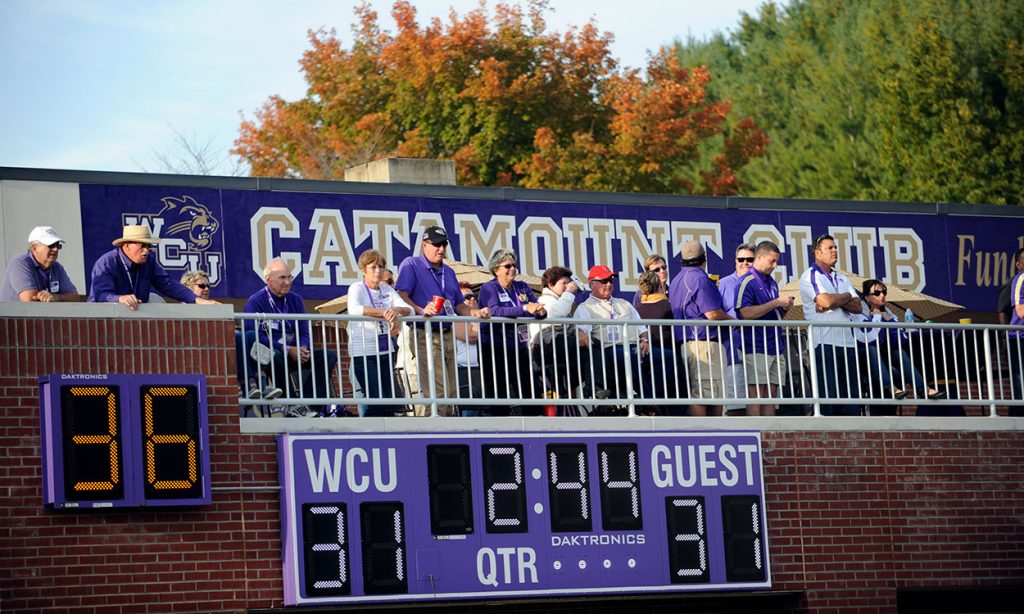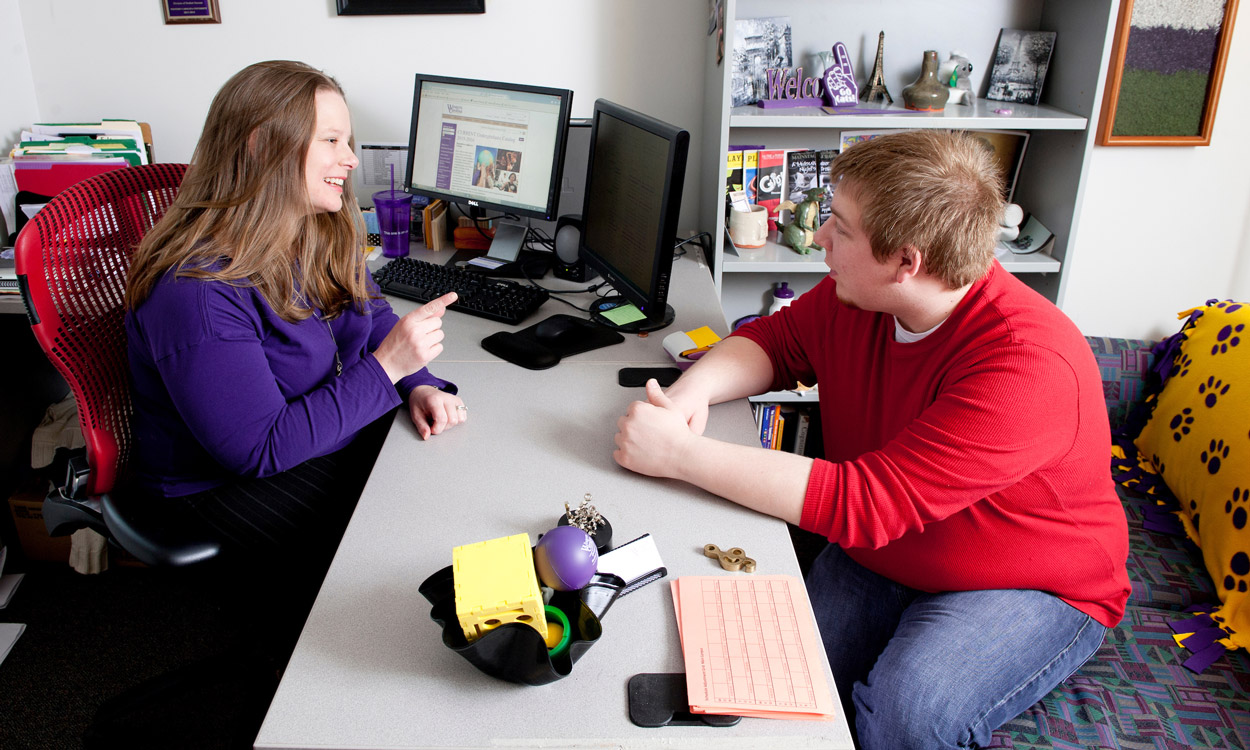Catamount Club is going strong after 50 years
Long gone are the days when Baxter Wood, a 1958 Western Carolina University graduate and former director of A.K. Hinds University Center, hauled members of the men’s basketball team to away games in his new 1958 Chrysler New Yorker or when community members took out personal loans to field the football team, repaid with gate receipts at the end of the season. Or, when Norman West, a 1968 alumnus, sold off “commemorative” pieces of a goal post torn down after a big win over Appalachian State to pay for new goal posts.
They’re funny stories now, and nearly unbelievable, but you know they are true because they represent the heart and soul of a community that loves its Catamounts. It’s a love that has manifested itself into what is known today as the Catamount Club, celebrating its 50th anniversary this year as the primary fundraising arm for WCU athletics.
“You always have to understand where you came from, how you got there and how the history can help build upon the future,” said Ryan Jones, director of the Catamount Club, who laughs and shakes his head at the gate receipts story from well before WCU was a part of the NCAA.
But he and others at WCU understand the intensity of a fan base so devoted to its teams that, in its early years, it did what it took to keep them playing, year after year, regardless of wins and losses. It’s an investment, after all, in an institution that has become family to so many of its alumni, faculty, staff and community members. As the university has grown, so has the Catamount Club – from fewer than 200 members in the late 1960s to more than 1,400 today, with scholarship support exceeding $1.6 million. And its mission has evolved too – from a club for season ticketholders more than 50 years ago to a premier fundraising organization that focuses on helping student-athletes achieve their ultimate potential.
“People see our student-athletes and they see the progress they’re making from the time they come in here as freshmen to when they exit and graduate as seniors, both as athletes and as students,” Jones said.
The club’s goal is to eventually provide every one of WCU’s 350 student-athletes with some scholarship support, a goal that resonates with Catamount Club members, said Randy Eaton, WCU’s athletic director. “Our members understand that we are a ‘student-athlete first’ organization, and they buy in to this concept,” Eaton said. “In addition, the folks who have joined the Catamount Club understand it is more than just an organization to support student-athletes. At its core, it is about supporting the entirety of Western Carolina University. We in athletics are simply a piece of the whole, and everyone affiliated with the Catamount Club understands that fact.”
But with so many colleges and universities fielding athletic teams these days, recruiting top student-athletes is a challenge, said 1967 graduate Steve White, former WCU sports information director who also served as director of the Catamount Club from 1970-77. “I think the biggest thing is if you’re going to compete, you’ve got to be able to give them scholarships. You can’t expect them to come here on quarter scholarships and half scholarships. You’ve got to have a commitment financially to them,” White said.
Increasing scholarship support for students was late Chancellor David O. Belcher’s priority when he arrived at WCU in 2011. Gorham Bradley, a 2004 graduate who formerly coached men's golf and directed the Catamount Club, said Belcher’s commitment to philanthropy combined with Eaton’s business acumen and commitment to developing student-athletes was pivotal to the club’s surge in membership and financial gifts. “The Catamount Club’s growth over the last 10 years is a perfect recipe of when you have leadership that put a priority on athletic fundraising and who made an investment in their volunteers and their board of directors,” said Bradley, who left WCU in 2017 for the private sector. “They created a very clear vision for why financial support from the Catamount Nation was important.”
 The Catamount Club started in 1968 when 1948 alumnus Jim Gudger, WCU’s basketball
coach and interim athletic director, and Clint Dodson, head of WCU’s science department,
expressed a desire for a fundraising organization to help with athletic expenses.
Back then it was called the Big Cat Club. Dodson was its first official member and
Tom Bommer, a 1972 graduate, was its executive director.
The Catamount Club started in 1968 when 1948 alumnus Jim Gudger, WCU’s basketball
coach and interim athletic director, and Clint Dodson, head of WCU’s science department,
expressed a desire for a fundraising organization to help with athletic expenses.
Back then it was called the Big Cat Club. Dodson was its first official member and
Tom Bommer, a 1972 graduate, was its executive director.
“Big Cat Club was the first time you had money going toward anything other than season tickets and operation money,” White said. “They started to create some scholarships. The first year, I raised $75,000 and we thought we were doing great.”
As the university grew, so did the needs of its athletic department, especially with the expansion of women’s sports in the 1970s. “I was involved with the Catamount Club from the get-go, not necessarily as a member, but because I was a coach,” said Susan Fields Persons, 1970 alumna, former women’s gymnastics coach and cheerleader sponsor, and a Catamount Club member. “I was always looking to them for help and support.”
When the gymnastics team needed new equipment or when the cheerleaders were on the road, there were always donors willing to pay for dinners or find the needed funds to help the team. “It was a family,” she said of the Catamount Club. “If a family member saw a need of one of its own, they took care of each other.”
Jim Wood , a 1983 graduate who is president of the Catamount Club board of directors, agrees with that perception of family and hopes to encourage more alumni and fans of WCU to engage in the university’s various activities, whether athletic or not. “You look at the people who have a vested interest in Cullowhee, in Western Carolina University and in the Catamount Club,” he said. “It spans multiple generations of parents, grandparents, grandchildren. I have friends, people I graduated with, who serve on all of these university boards, and all of these people have such a love for the university and for athletics. If you look at the things we’re doing from an athletic standpoint, it’s impressive. You see these students as such quality individuals both athletically and academically.”
As the Catamount Club looks to its next 50 years, WCU athletic administrators say their focus will be to continue developing their student-athletes and finding success in creating quality ambassadors for WCU.
“To me, the biggest component of moving the Catamount Club forward is to maintain our focus on the student-athlete,” Eaton said. “While wins and losses are important to all of us – we are in athletics after all – we cannot solely focus on winning. What we do, and what the Catamount Club helps ensure, is that we address the whole person. Not just the ‘student,’ not just the ‘athlete,’ but the ‘student-athlete.’ All of us want these young men and women to win every game, graduate on time and do it all with class – a lofty target, but one worth pursuing.”

